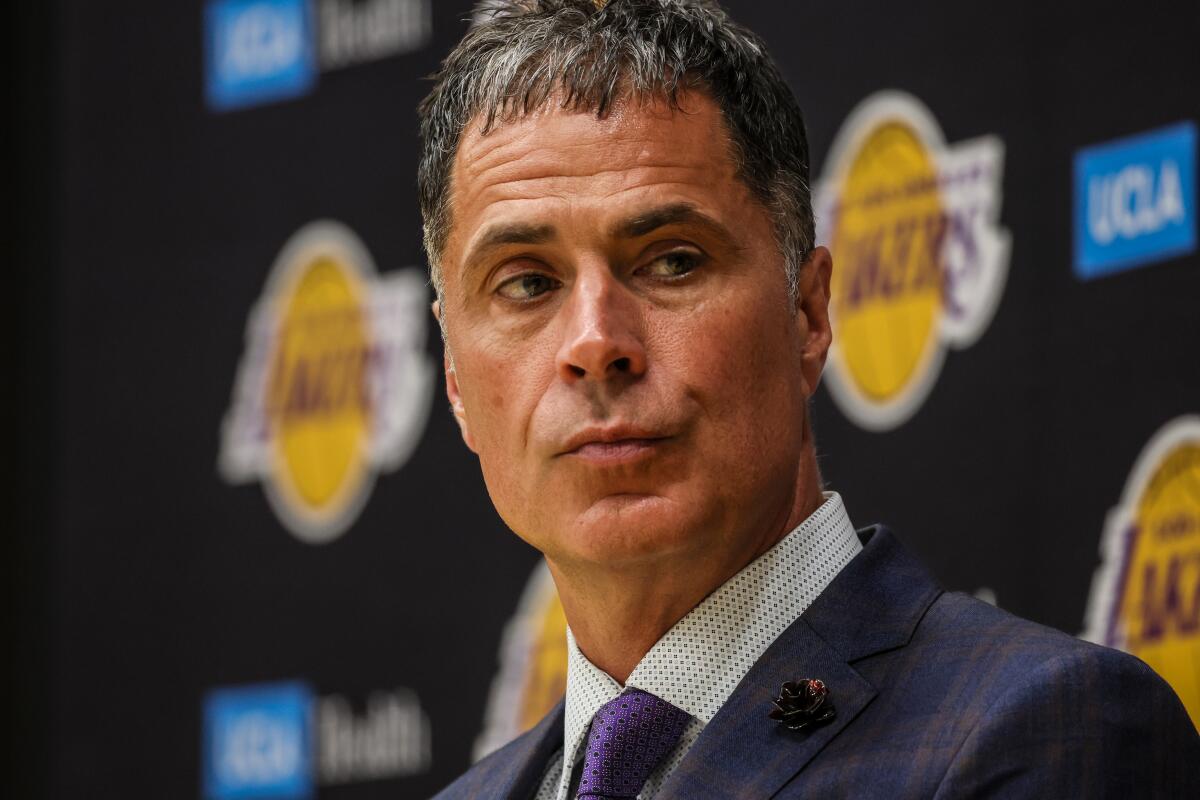Lakers newsletter: Why have the Lakers been so slow to upgrade their roster?

- Share via
Hey everyone, and welcome to the latest edition of the Lakers newsletter. This week, as I pack for Las Vegas — again — ahead of seven days of basketball in a place hotter than the inside of a pizza roll, I’m going to do my best to explain the dilemma the Lakers are currently facing.
Well, at least one of them.
All things Lakers, all the time.
Get all the Lakers news you need in Dan Woike's weekly newsletter.
You may occasionally receive promotional content from the Los Angeles Times.
Better off Ted
The Wikipedia page for Ted Stepien is a real roller coaster ride. There’s professional softball leagues with Whitey Ford, fired Cleveland Cavaliers coaches, racial ignorance, a lot of fired coaches and a ton of traded draft picks.
The last of those is why the page was open on my laptop Wednesday night, the Lakers’ roster functionally the same as it was in the spring with limited pathways to making meaningful change.
Rightfully, the tone in my mentions on social media and in my emails has been somewhere between antsy and full-on annoyed with the Lakers’ front office for inaction. The addition of two rookie players and a rookie head coach are hardly reasons to believe in a Lakers transformation from a first-round exit to a Celtics-tying 18th championship.
So why are the Lakers in this position? And what does that softball-owning weirdo have to do with any of this?
Player options
The Lakers went into last offseason with some momentum, riding high on the back of the Russell Westbrook trade and a Western Conference Finals appearance. Continuity was the marching order and, to get help around the edges, three of the Lakers’ free agent signees were offered player options to accept minimum contracts.
Christian Wood and Cam Reddish both battled ineffectiveness and injuries and couldn’t sustain any contribution. Jaxson Hayes should show some promise late in the season, but because he’s not a floor-spacer and not the kind of player who you’d send out on Nikola Jokic for long stretches, his upside with the Lakers was always kind of limited.
Anyway, all three decided to come back.
A cool free-agent market (more on that below) kept D’Angelo Russell from testing the waters. Add in rookies Dalton Knecht and Bronny James and LeBron James and boom, that’s a full roster.
With no room for anyone, the Lakers had to sit out free agency.
Get to the phones
Heading into this summer, executives around the league were aware of two truths.
One, this wasn’t a top-tier free agent class.
Two, with trades the primary pathway for meaningful changes, the first and second apron rules were going to be a real pain.
The latter has the Lakers living in a pretty rough situation. One, they’re operating with virtually no leverage in what is looking like a seller’s market. Because teams over the first apron are not allowed to take back more money in a trade, teams below that apron are the more preferred trade partners (other teams, hypothetically, could make a trade where the dollar amounts are exactly equal, but that’s not easy to pull off).
If the Lakers want to make a deal where they clear roster space — maybe enough to create room to use the taxpayer mid-level exception in free agency — that’s going to come at a real cost, because again, no leverage.
OK, so let’s say a big trade becomes available. Here’s where our good friend Ted comes in.
Because Stepien spent draft picks so irresponsibly, the NBA instituted a rule where teams couldn’t trade first-round picks in consecutive years.
That means, as of today, the Lakers have access to their 2029 and 2031 first-round picks. Their 2025 first-rounder belongs to the Pelicans, locking 2026. The 2027 first-rounder belongs to Utah unless it’s in the top four, and then it stays with the Lakers.
And because that pick’s protections means it becomes a second-rounder for Utah if it lands in the top four (instead of conveying to 2028), the Lakers have 2029 and 2031 to deal (with 2028 and 2030 locked because of the Stepien Rule).
All of those rules, though, make it harder for the Lakers to pull off the kind of deal they might want. If the team trades a 2029 first-round pick, the protections can’t roll over to the first round of 2030 (because if they do, it triggers the Stepien Rule and makes 2031 unavailable to deal). And because you can’t convey a 2031 pick to 2032 (those picks can’t be dealt yet), again, protecting it can be complicated.
The Lakers do have five second-round picks between now and 2031 to trade (as well as pick swap in the Stepien years) should they need them.
The existential stuff
OK, so that’s what the Lakers have, in addition to their players, to put into a trade. If that’s what goes out, now what comes back? And is it worth it?
I can’t pretend to say I know exactly what kind of deals the Lakers are kicking around, but I do think I understand the hesitancy to act without a clear improvement to the current roster.
And the limitations to what they have to offer, also with the great value 2029 and 2031 unprotected (or lightly protected) picks have, make it hard for a deal to really align.
Take a player like Dorian Finney-Smith, who has a $15-million contract with a player option for the following season. There’s some promise for a wing with size who can shoot the three and play high-level defense in Finney-Smith — he’s done it in the past. And let’s say his shooting struggles late in the last season were more a product of the Nets being directionless than anything else.
Getting him from Brooklyn will require at least $15 million in salary (Gabe Vincent and Christian Wood isn’t enough) and draft compensation. And if that compensation is a future first-round pick, is the upgrade meaningful enough to take one of the two first-round picks out of the Lakers’ trade chest?
I’m not qualified to answer, but the Lakers’ inaction when it comes to making a deal speaks to their thoughts right now.
Add in the closing window on LeBron James (soon to be 40) and Anthony Davis as the Lakers’ core, and the front office has to be asking itself what it should invest in this group? It also needs to be asking itself if the organization can afford to wait.
Complicated, right?
There’s a chance they could be waiting for the market to settle in some, the first few waves of free agency having come and gone. Maybe that opens up more trade pathways.
Also, Friday, Summer League starts in Las Vegas, with every exec of note converging on the city discussing possible deals. Maybe something comes of all that.
It’s not easy and it’s on Lakers general manager Rob Pelinka to figure it out. But there are reasons this summer has been quiet for the Lakers.
Song of the week
“Same in the End” by Sublime
Maybe the roster will be the same in the end (I think I’d still bet against that…), but this song from the Sublime record that always gets a spin in my car during the summer makes the same, at least, sound entertaining.
In case you missed it
LeBron James says pay cut was about making sure his relationship with Lakers works
Lakers’ stagnant offseason doesn’t worry Anthony Davis
Plaschke: LeBron James’ new deal confirms the Lakers’ offseason is a bust
Granderson: Bronny James is seeing the downsides of being a nepo baby
‘It ain’t really my thing’: Which Team USA members can spin a ball on their fingers?
Lakers struggle on offense, drop second California Classic game
Bronny James sits out Lakers’ game Sunday because of a swollen knee
‘Growing comfortable’: Bronny James is hit and miss in Lakers debut
LeBron James says Bronny’s summer league stats don’t matter
Until next time...
As always, pass along your thoughts to me at [email protected], and please consider subscribing if you like our work!
All things Lakers, all the time.
Get all the Lakers news you need in Dan Woike's weekly newsletter.
You may occasionally receive promotional content from the Los Angeles Times.




